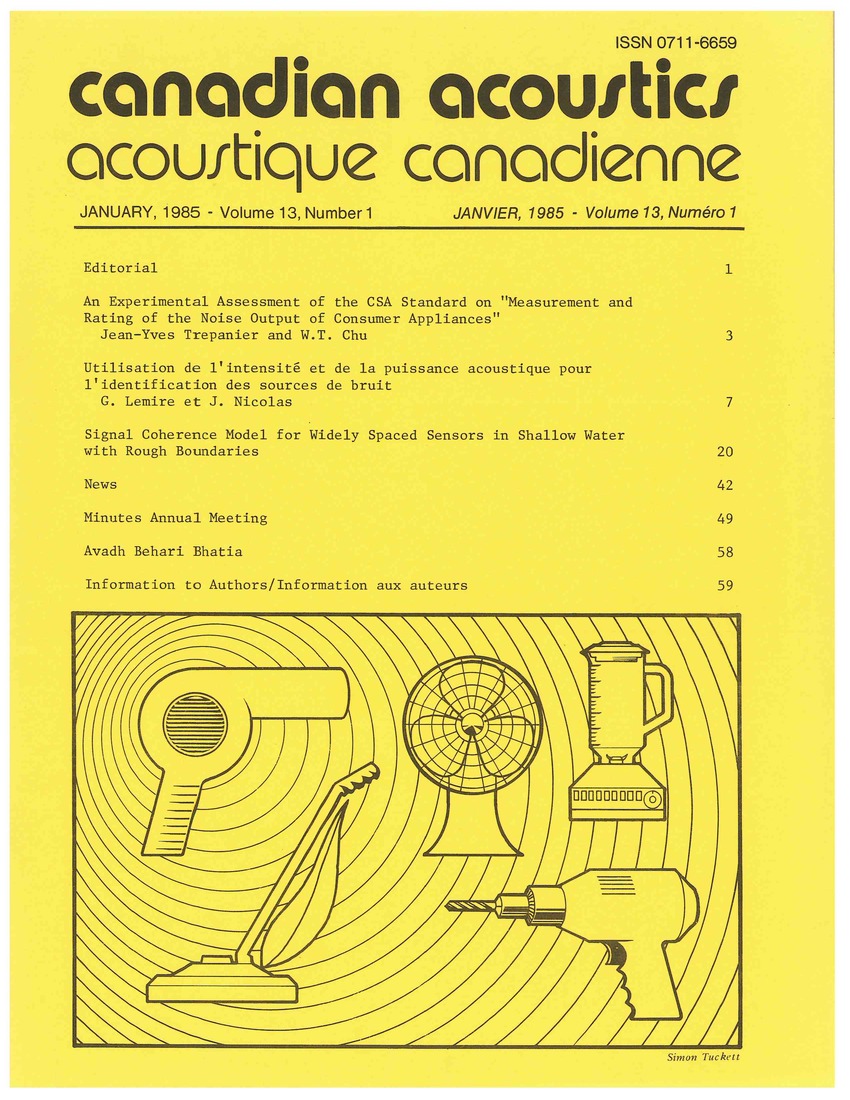Signal coherence model for widely spaced sensors in shallow water with rough boundaries
Mots-clés :
underwater sound, shallow water, rough boundaries, normal modes, waveguide, signal coherence, source-receiver rangeRésumé
Un modèle, basé sur les modes normaux, a été développé pour prédire la cohérence d'une source sonore située en eau peu profonde limitée par des surfaces irrégulières. L'amplitude et la phase d'un signal certain sont calculées a partir du modèle a modes normaux; des variations aléatoires d'amplitude et de phase sont ensuite ajoutées. Le modèle assume que les fluctuations de phase du mode sont introduites par l'irrégularité des surfaces du guide d'onde, et qu'elles possèdent un degré d'indépendance arbitrairement choisi. Cette indépendance est prévue afin d'inclure le cas des récepteurs grandement espacés. La disposition des récepteurs ne comporte aucune restriction. La source, cependant, est contrainte aux déplacements pour lesquels la distance la séparant du récepteur est constante, ou pour lesquels la distance varie de plusieurs longueurs d'onde a l'intérieur de la période requise pour l'estimation de la cohérence. Lorsque la distance entre la source et le récepteur varie rapidement et que les récepteurs sont faiblement espacés, il est observé que la cohérence est fonction de la séparation entre les récepteurs, de la forme du mode et de son excitation. Pour des récepteurs peu distancés, une configuration dont la direction de la source est perpendiculaire aux récepteurs procure une très grande cohérence. Dans le cas où l'espacement est grand et/ou que la distance "source-récepteur" est maintenue constante, l'irrégularité des limites du guide d'onde a un effet considerable sur la cohérence. Il est également observé que certaines configurations peuvent être utilisées afin d'isoler l'effet de chaque paramètre et ainsi en déterminer expérimentalement leurs valeursFichiers supplémentaires
Publié-e
Comment citer
Numéro
Rubrique
Licence
Author Licensing Addendum
This Licensing Addendum ("Addendum") is entered into between the undersigned Author(s) and Canadian Acoustics journal published by the Canadian Acoustical Association (hereinafter referred to as the "Publisher"). The Author(s) and the Publisher agree as follows:
-
Retained Rights: The Author(s) retain(s) the following rights:
- The right to reproduce, distribute, and publicly display the Work on the Author's personal website or the website of the Author's institution.
- The right to use the Work in the Author's teaching activities and presentations.
- The right to include the Work in a compilation for the Author's personal use, not for sale.
-
Grant of License: The Author(s) grant(s) to the Publisher a worldwide exclusive license to publish, reproduce, distribute, and display the Work in Canadian Acoustics and any other formats and media deemed appropriate by the Publisher.
-
Attribution: The Publisher agrees to include proper attribution to the Author(s) in all publications and reproductions of the Work.
-
No Conflict: This Addendum is intended to be in harmony with, and not in conflict with, the terms and conditions of the original agreement entered into between the Author(s) and the Publisher.
-
Copyright Clause: Copyright on articles is held by the Author(s). The corresponding Author has the right to grant on behalf of all Authors and does grant on behalf of all Authors, a worldwide exclusive license to the Publisher and its licensees in perpetuity, in all forms, formats, and media (whether known now or created in the future), including but not limited to the rights to publish, reproduce, distribute, display, store, translate, create adaptations, reprints, include within collections, and create summaries, extracts, and/or abstracts of the Contribution.


